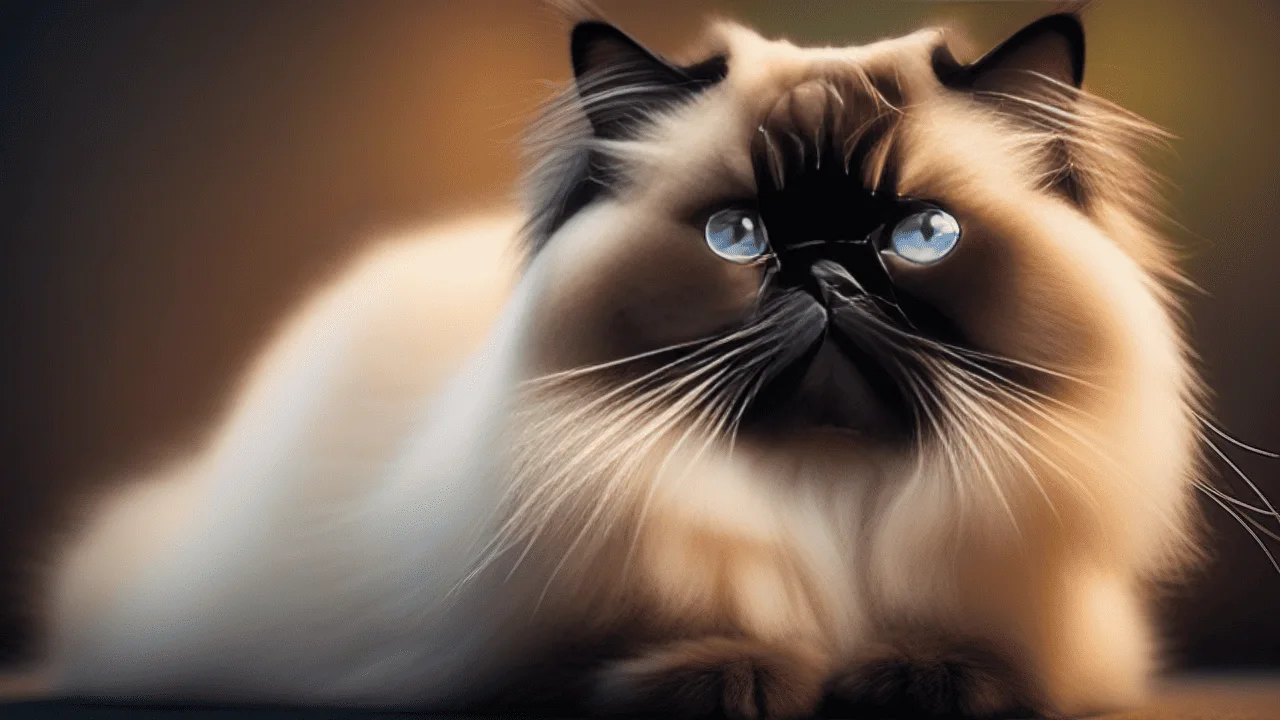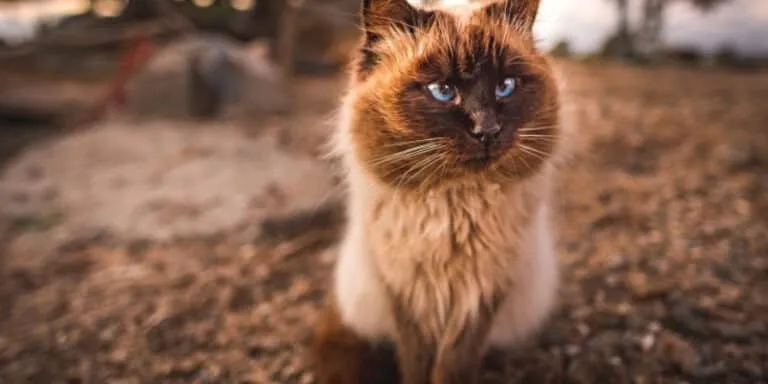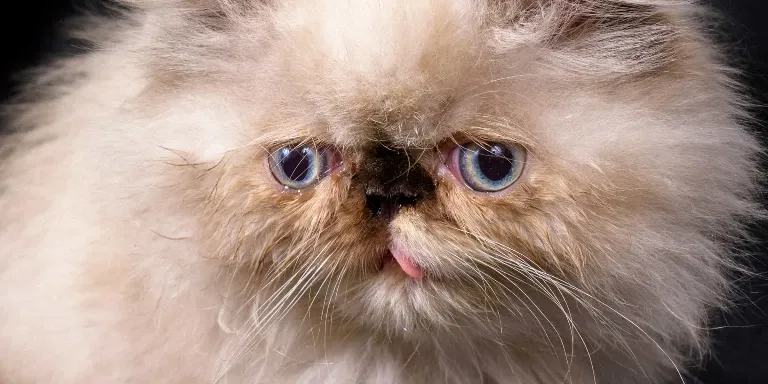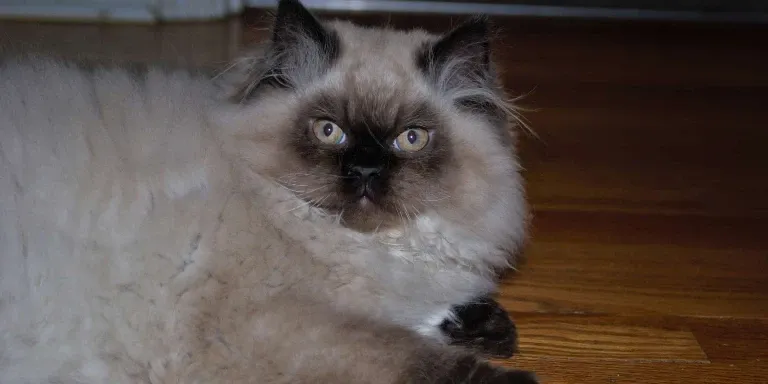The Best Fluffy Pancakes recipe you will fall in love with. Full of tips and tricks to help you make the best pancakes.

Do you ever wonder how the Himalayan cat breed came to be? It’s a fascinating story of crossbreeding and selective breeding.
The Himalayan cat is a result of crossbreeding two popular breeds – Persian and Siamese cats.
The history of the Himalayan cat breed dates back to the 1920s when breeders in the United States started experimenting with crossbreeding Persian and Siamese cats. They were looking to create a cat with the Siamese’s striking blue eyes and the Persian’s long, luxurious coat. The result was a cat with a beautiful, fluffy coat and piercing blue eyes – the Himalayan cat.
Since then, it has become one of the most popular cat breeds in the world, known for its loving personality and stunning appearance. In this article, we will explore the history of the Himalayan cat breed, its appearance, personality traits, and how to care for one.
History of the Himalayan Cat Breed
Let’s dive into the history of the Himalayan cat breed and find out which two adorable breeds came together to create this fluffy feline!
The Himalayan cat breed came to be in the 1930s through breeding methods that involved crossing the Persian and Siamese cat breeds. The goal was to create a breed that had the physical characteristics of a Persian cat but the striking blue eyes of a Siamese cat.
The genetic mutation that resulted in the Himalayan cat’s distinctive coloring was unintentional. The Siamese breed has a gene that determines the temperature-sensitive pigment in its fur. When the breed was crossed with the Persian, the gene responsible for white fur was introduced, which caused the dark pigment to be restricted to the cat’s extremities.
This resulted in the Himalayan cat’s signature coat color, which is characterized by a light-colored body and dark points. Today, the Himalayan cat breed is recognized by many cat associations and continues to be a favorite among cat lovers worldwide.
Persian Cat
The Persian feline is a majestic creature with a luxurious coat that is often the envy of other cat owners. This breed is believed to have originated in Persia (modern-day Iran) and was brought to Europe in the 17th century. Persians have a distinct flat face, round head, and short, stocky body.
To keep a Persian’s coat looking its best, grooming is essential. Here are some grooming tips for Persian cats:
- Brush their coat daily to prevent matting and tangling.
- Use a metal comb to get rid of any knots or tangles.
- Bathe them once a month to keep their coat clean and shiny.
- Trim their nails every two weeks to prevent them from getting too long.
However, despite their beauty, Persian cats are prone to some health concerns. These include breathing problems due to their flat faces, eye infections, and kidney disease. It’s important to take your Persian to the vet regularly and keep up with their vaccinations to prevent any health issues from arising.
Siamese Cat
If you’re looking for a cat that’s both affectionate and talkative, you might want to consider adopting a Siamese. These cats are known for their outgoing personalities and their love for human interaction. They’re energetic and playful, and they love to be the center of attention.
Siamese cats are also known for their unique behavior. They’re very vocal and will often meow to get their owner’s attention. They’re also very intelligent and can be easily trained. However, it’s important to note that Siamese cats can be prone to certain health concerns, such as respiratory problems and dental issues.
As with any pet, it’s important to provide regular veterinary care to ensure their health and well-being.
Crossbreeding Persian and Siamese Cats
If you’re interested in crossbreeding Persian and Siamese cats, there are a few key points to consider.
Firstly, it’s important to understand the purpose of the crossbreeding. Typically, breeders aim to combine the desirable physical traits of both breeds, resulting in a unique and visually striking cat.
However, there are also challenges to crossbreeding, such as potential genetic health issues and difficulty in predicting the final outcome.
Despite these challenges, there have been successful crossbreeding efforts resulting in beautiful and healthy Persian-Siamese hybrids.
Purpose of Crossbreeding
Although crossbreeding may seem controversial, it can serve a purpose in creating unique and healthy cat breeds.
For example, the Himalayan is a result of breeding Persians and Siamese cats. The benefits of crossbreeding include producing a hybrid with desirable traits from both parent breeds, such as a Himalayan’s luxurious fur and affectionate personality.
Crossbreeding can also increase genetic diversity and reduce the risk of inherited diseases prevalent in certain purebred lines.
However, it is important to keep ethics in mind when crossbreeding, ensuring it is done responsibly and with the welfare of the animals in mind.
It is crucial to avoid harmful or unethical breeding practices that could lead to health issues or suffering for the cats involved.
By carefully selecting parent cats with good health and temperament and following proper breeding practices, we can create new and unique cat breeds like the Himalayan that are both healthy and beautiful.
Challenges and Successes
Crossbreeding poses unique challenges for breeders, but when done responsibly, it can lead to exciting successes in creating new and healthy feline hybrids.
One of the biggest challenges breeders face when crossbreeding is overcoming health challenges. When two different breeds are combined, genetic health issues from both breeds can arise in the offspring. It’s crucial for breeders to thoroughly research and test for potential health problems before breeding to ensure the well-being of the hybrid cats.
Another challenge breeders face is adjusting to a new environment. When breeding two different breeds, the hybrid offspring may exhibit traits from both breeds, making it difficult to predict how they will adapt to their new surroundings. Breeders must carefully monitor the behavior and health of the hybrid cats and make adjustments as needed to ensure their comfort and safety.
Despite these challenges, successful crossbreeding can result in the creation of unique and healthy feline hybrids that bring joy to their owners and contribute to the diversity of the cat world.
Appearance of the Himalayan Cat
You’ll immediately notice the striking appearance of a Himalayan cat, with their long, fluffy fur and distinctive coloring. Here are four key features that make this breed stand out:
- The Himalayan cat has a pointed face, with deep blue eyes that are almond-shaped and set wide apart.
- Their fur is long and silky, with a range of color variations, including seal point, blue point, chocolate point, and lilac point.
- The body of the Himalayan cat is compact and muscular, with short legs and a short, thick tail.
- To maintain their luxurious coat, Himalayan cats require regular grooming, including daily brushing and occasional bathing.
Overall, the Himalayan cat’s appearance is a combination of their Siamese and Persian ancestry, resulting in a unique and beautiful breed. If you’re looking for a cat with striking features and a regal presence, the Himalayan cat may be the perfect companion for you. Just be prepared for the grooming requirements that come with their stunning coat!
Personality Traits of the Himalayan Cat
Now that you’ve learned about the physical appearance of the Himalayan cat, let’s delve into their personality traits.
These cats are known for their sweet and affectionate nature, making them wonderful pets for those who seek companionship and love. Himalayan cats have a gentle temperament and are often described as docile and calm, which makes them great lap cats.
However, it’s important to note that each cat has its own unique personality, and Himalayan cats are no exception. Some may have a more independent streak or exhibit behavior quirks, such as being easily startled or shy around strangers.
It’s important to spend time with your Himalayan cat to understand their individual personality and needs to ensure they are happy and healthy. With proper care and attention, your Himalayan cat can become a beloved member of your family.
Caring for a Himalayan Cat
Taking care of a Himalayan feline requires regular grooming, as their long fur tends to mat easily, but it’s worth the effort to have a cuddly companion who loves to curl up on your lap.
To keep your Himalayan cat healthy and happy, here are some grooming requirements you need to follow:
- Brush their fur daily to prevent matting and hairballs.
- Bathe them once a month to keep their coat clean and shiny.
- Trim their nails regularly to prevent them from scratching furniture and people.
When it comes to health concerns, Himalayan cats are prone to certain conditions such as respiratory problems, dental issues, and kidney disease. To ensure that your cat stays healthy, you should take them to the vet for regular check-ups and vaccinations.
Additionally, you need to provide them with a balanced diet and plenty of exercise. With proper care and attention, your Himalayan cat can live a long and happy life.
Choosing a Himalayan Cat
If you want a furry companion that’s both cuddly and stylish, consider adding a Himalayan feline to your household. These cats are a crossbreed between the Persian and Siamese breeds, resulting in a unique and gorgeous appearance.
The Himalayan cat has a long, fluffy coat with striking colors on their face, ears, and tail. However, owning a Himalayan cat requires a bit of work when it comes to grooming requirements. Due to their long coat, they need to be brushed regularly to prevent matting and hairballs. Additionally, their eyes require daily cleaning to prevent discharge buildup and potential infection.
As for health concerns, Himalayan cats are prone to respiratory issues and kidney disease, so it’s essential to keep them in a clean and low-stress environment. With proper care, a Himalayan cat can be a loving and beautiful addition to any household.
Are Himalayan cats good house pets like Persian cats?
Himalayan cats make wonderful house pets, much like Persian cats. Both breeds are known for their gentle and affectionate nature, making them perfect companions for families. However, it’s important to note that Himalayan cats, like Persian cats as house pets, require regular grooming to maintain their long, luxurious coats.
Final Thoughts
Congratulations! You now know what breeds make up the Himalayan cat. The Himalayan cat is a result of crossbreeding between the Persian and Siamese cats. The Persian cat is known for its long, silky fur and round face, while the Siamese cat is known for its triangular face and pointy ears.
The Himalayan cat takes on the best of both breeds, making it a beautiful and unique pet. But owning a Himalayan cat isn’t just about their unique appearance. They also have a distinct personality that sets them apart from other cat breeds. They’re affectionate, playful, and intelligent, making them great companions for any cat lover.
However, their long fur requires frequent grooming, and they can be prone to health issues such as respiratory problems and eye infections. Despite their grooming needs and health concerns, owning a Himalayan cat can be a rewarding experience. Their unique appearance and personality make them stand out from other cat breeds, and their affectionate nature can make them a great addition to any family.
So, if you’re considering bringing a Himalayan cat into your home, make sure you’re prepared to give them the care and attention they deserve.








